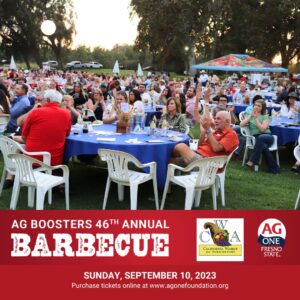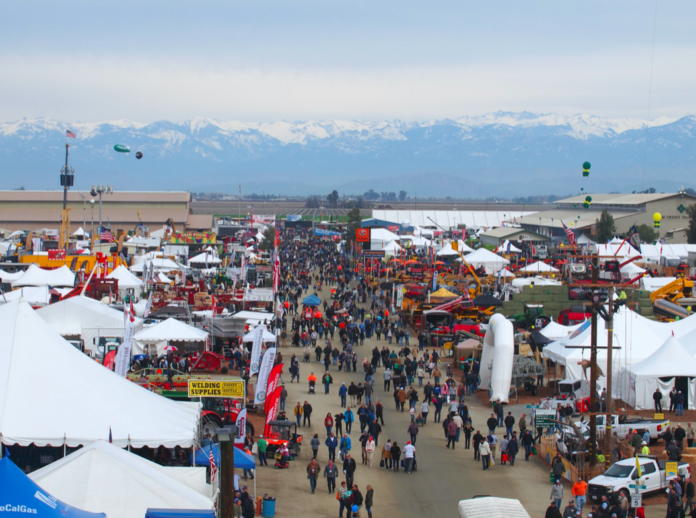By Don A. Wright
The Tulare Irrigation District held its board of directors meeting on Tuesday, August 8, 2023 at its Tulare headquarters. Its headquarters are actually a bit out of town to the west. It’s old news now but the “new” buildings and offices are very nice. The boardroom is a decent size for staff, management and the public to attend and be able to get a seat by an electrical plug if you get there early enough. I haven’t physically attended in some time now, as they request the public to show up online – they are Zoomers so that’s pretty OK in the age of $5 per gallon gas.
decent size for staff, management and the public to attend and be able to get a seat by an electrical plug if you get there early enough. I haven’t physically attended in some time now, as they request the public to show up online – they are Zoomers so that’s pretty OK in the age of $5 per gallon gas.
I do miss seeing everyone and the breakfast burritos are way above average. Director Mike Thomas has a dog that rides around in the back of his truck and waits in the shade for the meeting to end. I don’t know the dog’s name but she looks mostly border collie and some day I might tell you the full story of my old cow dogs Sydney and Lucy – the girls – but you’d have to promise not to cry or you’ll get me started. They were very sweet unless you were a squirrel. We used to live on a horse ranch on an island in a river east of Madera. Had an old recliner I liked to sit in. The girls liked to sit in it too. If Lucy, she was an Australian Shepherd, was sitting in the chair Sydney, the border collie would go to the door and bark. That made Lucy run over to the door and bark too. So then Sydney would double back and get in the chair. One cold winter’s evening I was sitting reading and Sydney began barking. Lucy ran over to the door and joined. They wouldn’t stop so I got up to see what was going on. Even stepped outside with a flashlight as they were really barking up a storm. Then I noticed only Lucy and I were outside in the cold and dark and Lucy had stopped barking. We went back in the house and there was Sydney in my chair.
Madera. Had an old recliner I liked to sit in. The girls liked to sit in it too. If Lucy, she was an Australian Shepherd, was sitting in the chair Sydney, the border collie would go to the door and bark. That made Lucy run over to the door and bark too. So then Sydney would double back and get in the chair. One cold winter’s evening I was sitting reading and Sydney began barking. Lucy ran over to the door and joined. They wouldn’t stop so I got up to see what was going on. Even stepped outside with a flashlight as they were really barking up a storm. Then I noticed only Lucy and I were outside in the cold and dark and Lucy had stopped barking. We went back in the house and there was Sydney in my chair.
The Meeting
The meeting was scheduled to start at 9:00am but went into closed session first. It was supposed to come back to open session at 10:30am. The closed session stopped at 10:47am and the proceedings took back up after a break. There were some members of the public there, so it’s not forbidden to attend in person. We got a chance to listen in on the chatter just before the meeting resumed in open session. I heard someone say the corn crop is coming in late. I’ve heard the same thing about a variety of crops maturing late for harvest.
Water Report
Chairman Dave Bixler called the meeting to order at 10:50am and things jumped right into the water report. Of course my phone rang right then and it was a very important client but I still heard most of Water Master Marco Crenshaw’s report. TID has maximized the uncontrolled season as best they could. Turns out 2023 is one of the top four best years for taking water from the Friant Kern Canal and the top year for delivering recharge to its growers, if I understood correctly. They’ve taken 34,700 a/f from the FKC and 50,450 from the Kaweah River so far this year. That’s about 85,195 a/f feet as of yesterday. I think there is still a good slug of water at Lake Kaweah with TID’s name on it. Isn’t it a blessing to have a great year. Whoops, I just saw a slide that showed a 316,000 a/f total for water taken into TID for the year so far. That sounds more like it. I’m guessing the other figures were for the month. I don’t know sorry. If I interrupted a meeting with questions every time I didn’t know what was being talked about, well it’d make me unwelcomed. I suspect there’s a reader out there who could help me on the above point.
years for taking water from the Friant Kern Canal and the top year for delivering recharge to its growers, if I understood correctly. They’ve taken 34,700 a/f from the FKC and 50,450 from the Kaweah River so far this year. That’s about 85,195 a/f feet as of yesterday. I think there is still a good slug of water at Lake Kaweah with TID’s name on it. Isn’t it a blessing to have a great year. Whoops, I just saw a slide that showed a 316,000 a/f total for water taken into TID for the year so far. That sounds more like it. I’m guessing the other figures were for the month. I don’t know sorry. If I interrupted a meeting with questions every time I didn’t know what was being talked about, well it’d make me unwelcomed. I suspect there’s a reader out there who could help me on the above point.
Next General Manager Aaron Fukuda spoke about CVP matters. He said the US Bureau of Reclamation did a great job of estimating how much water and what color it is. That means there is a 100 percent Class I and a 15 percent Class II after the uncontrolled season  ended on July 29th. There are several maintenance tasks scheduled on various Central Valley Project facilities this winter. In the meantime TID’s $52 per a/f cost continues to incentivize surface supply irrigation.
ended on July 29th. There are several maintenance tasks scheduled on various Central Valley Project facilities this winter. In the meantime TID’s $52 per a/f cost continues to incentivize surface supply irrigation.
O&M
Wayne Fox gave his Superintendent report. Fukuda said the TID crew is understaffed with two new employees; one of whom worked for a Lake Bottom district. He’s not heard any complaints. Fox said they’ve been filling the gaps on maintenance by priority. I hope I heard wrong but I think I heard TID’s customized spray rig’s engine is leaking oil. It’s an old engine and I’ll take it apart for a modest fee. Someone else will have to put it back together.* TID built its own spray rig when it couldn’t find one for sale.
Fox said crews are dealing with weeds in and along the ditches. There have also been more leaks in the canals which makes sense – lots more water this year.
Financials
Kathy Artis gave her report and began with a budget to actual comparison. Everything is tracking as it should. There was a long period of silence as the farmers on the board perused the accounts payable. Eventually they approved paying the bills and the report. In the past 25-30 years I’ve only heard about two cases of financial funny business in a California public water entity. Farmers don’t put up with that.
Engineers Report
Fukuda gave the report and there is a new park going into one of the City of Visalia’s ponding basins. It will include a golf course as well. Looks pretty good on paper. Visalia is one of the better looking cities in the San Joaquin Valley as far as I’m concerned. They’ve preserved their old architecture and still have a thriving downtown. There are good restaurants and the convention center is more than one would expect for a city of its size. There’s a creek that runs through town with nice homes along its banks. There was something else Fukuda said about residential development encroaching on TID canals or pipes or something at the edge of the district. I missed it while mentally rhapsodizing about Visalia.
Staff Reports
Fukuda said there was a meeting with the State Board last month on the Kaweah Subbasin Groundwater Sustainability Plan. He said this is the first of three meetings where there was an engagement with the State Board staff. He said the State wanted to know what this was, Plan B? He had to explain this is Plan A, without water supplies there is no Plan B. State Board staff actually asked to have a talk about the mitigation plan. Fukuda said it costs the Mid Kaweah GSA about $2,000 per hour in technical and legal expertise to sit around the table with State Board staff. He said the Kaweah Subbasin got its money’s worth as the team was very good. But he’s also aware of the costs and will be trying to organize Zoom meetings when feasible.
Domestic wells have become a very big deal under SGMA. MKGSA was able to use DWR guidelines in its minimum threshold. Raising the MT by 10 feet reduces the amount of mitigation by, I believe, 80 percent.
The greatest subsidence is taking place where the Kaweah Subbasin abuts the Tule Subbasin. Critical infrastructure was discussed with the county and there were no roads or other facilities under any threat. TID canals could be impacted and studies show the capacity loss would be easily made up by a day or two longer run. The MKGSA had to call for $540,000 as the grant money has been shipped by 20-Mule Team and hasn’t yet arrived. Some of the call will be reimbursable when the grant checks show up. If I understood the Visalia Country Club and its golf course now falls under MKGSA jurisdiction. Fukuda said the golf course will start following some of the changes TID growers have made in their irrigation practices. Director Dave Martin said he’s heard the bar will be using less ice in its cocktails. A cost share agreement has been approved for a data management service and some modeling for flows.
capacity loss would be easily made up by a day or two longer run. The MKGSA had to call for $540,000 as the grant money has been shipped by 20-Mule Team and hasn’t yet arrived. Some of the call will be reimbursable when the grant checks show up. If I understood the Visalia Country Club and its golf course now falls under MKGSA jurisdiction. Fukuda said the golf course will start following some of the changes TID growers have made in their irrigation practices. Director Dave Martin said he’s heard the bar will be using less ice in its cocktails. A cost share agreement has been approved for a data management service and some modeling for flows.
Friant
Fukuda said the EIR for water quality is on its way to acceptance. The Friant Kern Canal repairs include pouring concrete at night to avoid the heat and stay on schedule. There will be a November 14th to the 16th board retreat. This is a good time to get in on learning of and helping set, the direction of the Friant Water Authority.
McKay Point/Seaborn Reservoirs
Elected officials have been touring the projects and are all impressed and onboard.
Legislation
The bad bills were stopped from being enacted in Sacramento. There is a discussion about a water bond on next year’s ballot. ACWA and the Collaborative Action Plan are working on this. Martin asked why ACWA isn’t on board with the Water Blueprint for the San Joaquin. He said if ACWA was serious in helping all of California it would be a part of the Blueprint.
GM
Fukuda recently spoke on a panel, I think at Stanford University where he addressed a less ag-centric audience of agencies, cities, counties and consultants about the technology TID has adopted before SGMA. There was also a good case made for establishing cooperation between interests before the hard choices have to be made. It was a good chance for him to show how even though it wasn’t perfect, TID and its growers were prepared for the flood water this year. It took on recharge water and is better prepared by the experience for the next time.
between interests before the hard choices have to be made. It was a good chance for him to show how even though it wasn’t perfect, TID and its growers were prepared for the flood water this year. It took on recharge water and is better prepared by the experience for the next time.
Action Items
Resolution No. 23-10 was first. This is the Friant Kern Canal water quality agreement mentioned earlier. This was sent to the home boards of FWA members for approval. Fukuda said TID doesn’t pump water into the FKC. It might introduce Kaweah River water at some point but that is very clean water and isn’t likely to cause any water quality concerns. The board agreed and passed the resolution.
The next action item was to authorize the purchase of survey equipment for the district. The current equipment has been in use for 20 years, twice its guaranteed life. There is a lot of work needed under SGMA for flows and elevations. It would cost $285 per hour to hire someone to do this work. So purchasing the Leice Equipment gear for $37,000 and $2,500 annual network fee has been proposed. It’s also a cost share between TID and MKGSA. Staff wants a new toy and the father figures on the board obliged since it pays for itself in less than 22-hours of use. That is according to my journalist math. Remember journalist math brought you the Million Man March and to a great degree High Speed Rail. Anyway the discussion on this item took like 10-15 minutes.
Martin reported on assessment cost on a couple of ditch companies. Thomas reported on a couple of mounds and a drainpipe that looked like a recipe for disaster. He also said the Watchumna water rates are a bit high considering. That was about it for board reports.
There was no further business in open session and the closed session stuff was already dealt with (no reportable action.) The meeting then adjourned at 12:23pm. That was that.
DISCLAIMER OF RESPONSIBILITY; Waterwrights strives to provide clients with the most complete, up-to-date, and accurate information available. Nevertheless, Waterwrights does not serve as a guarantor of the accuracy or completeness of the information provided, and specifically disclaims any and all responsibility for information that is not accurate, up-to-date, or complete. Waterwrights’ clients therefore rely on the accuracy, completeness and timeliness of information from Waterwrights entirely at their own risk. The opinions expressed in this report are those of the author and do not represent any advertisers or third parties.
does not serve as a guarantor of the accuracy or completeness of the information provided, and specifically disclaims any and all responsibility for information that is not accurate, up-to-date, or complete. Waterwrights’ clients therefore rely on the accuracy, completeness and timeliness of information from Waterwrights entirely at their own risk. The opinions expressed in this report are those of the author and do not represent any advertisers or third parties.
*After two of my cousins drove it for years I inherited my grandpa’s 1960 Chevy El Camino. One day it stopped running. Fortunately and rarely in other auto dysfunction experiences, it conked within a two mile walking distance to my home. My brother and I towed it back to the barn and I decided to rebuild the engine. I ordered a Chilton manual but it was going to take a couple of weeks. I figured I could pull the motor and break it down while waiting. I removed the hood, stripped the top of that beautiful 327, took off all the motor mounts, exhaust and transmission bell housing bolts and attached a chain with a come-along to the block. I then hooked the come-along to the front scoop of our old Ford diesel tractor and started to lift it out of the engine well. As it started to rise up, the entire truck lifted off the ground. I missed a transmission bolt. Ok, got that removed and started again. I guess the strain was too much for the come-along because while the engine did slip right out, gravity took over right as I was backing up and the engine was over the right front quarter panel. The engine dropped and put a nasty dent in the fender and broke the headlamp. I just turned the tractor off and walked for about an hour before I came back to straighten out that mess. Eventually I took it all apart and laid out each part by cylinder on a folding table. It looked like a real life exploded view diagram. At last the Chilton showed up and I went to the barn ready to rebuild. A squirrel had built a nest in a cylinder in the block and one of the dogs (way before Syndey and Lucy) had gone crazy trying to catch it and knocked the table down. Parts were everywhere. I mean internal combustion pick up sticks. I never did finish rebuilding that engine. It’s a shame because that was one bad El Camino and I wish I still had it.
experiences, it conked within a two mile walking distance to my home. My brother and I towed it back to the barn and I decided to rebuild the engine. I ordered a Chilton manual but it was going to take a couple of weeks. I figured I could pull the motor and break it down while waiting. I removed the hood, stripped the top of that beautiful 327, took off all the motor mounts, exhaust and transmission bell housing bolts and attached a chain with a come-along to the block. I then hooked the come-along to the front scoop of our old Ford diesel tractor and started to lift it out of the engine well. As it started to rise up, the entire truck lifted off the ground. I missed a transmission bolt. Ok, got that removed and started again. I guess the strain was too much for the come-along because while the engine did slip right out, gravity took over right as I was backing up and the engine was over the right front quarter panel. The engine dropped and put a nasty dent in the fender and broke the headlamp. I just turned the tractor off and walked for about an hour before I came back to straighten out that mess. Eventually I took it all apart and laid out each part by cylinder on a folding table. It looked like a real life exploded view diagram. At last the Chilton showed up and I went to the barn ready to rebuild. A squirrel had built a nest in a cylinder in the block and one of the dogs (way before Syndey and Lucy) had gone crazy trying to catch it and knocked the table down. Parts were everywhere. I mean internal combustion pick up sticks. I never did finish rebuilding that engine. It’s a shame because that was one bad El Camino and I wish I still had it.
ALL RIGHTS RESERVED. Copyright 2023 by WaterWrights.net/DAW
TULARE IRRIGATION DISTRICT
6826 Ave 240, Tulare, CA 93274 Office: 559/686-3425
Board: David G. Bixler- President, Richard S. Borges, Jr.-Vice President, Scott Rogers, Dave Martin & Michael Thomas
Staff: Aaron Fukuda-General Manager, Jeremy Barroll-Engineer, Kathi Artis–District Controller, Wayne Fox–Superintendent, Marco Crenshaw–District Watermaster & Alex Peltzer-Attorney.
About: The Tulare Irrigation District was organized September 21, 1889. The original proposal for the formation of an irrigation district covering 219,000 acres, extending from the Sierra Nevada foothills to Tulare Lake, was eventually reduced to 32,500 acres. The District continued in this status until January of 1948 when the so-called Kaweah Lands” (approximately 11,000 acres) were annexed. In October of 1948, approximately 31,000 acres, compromising the area served by the Packwood Canal Company were annexed to the District. A U.S. Bureau of Reclamation contract was signed in 1950 providing an annual supply of 30,000 acre-feet of Class 1 water, and up to 141,000 acre-feet of Class 2 water from the Friant-Kern Canal. The District and the Kaweah Delta Water Conservation District have coordinated efforts to enhance the recharge of groundwater within the Kaweah Basin. During high flow times KDWCD may use the recharge basins with the District for recharge purposes. Further, KDWCD has historically provided for a financial incentive program through which the District sustains the level of groundwater recharge from supply sources into the District. This historical program was recently reinstated by both districts in lieu of the District’s plans to concrete-line this canal to conserve the surface water. TID is a member of the Mid Kaweah GSA DWR#-5-022.11
































